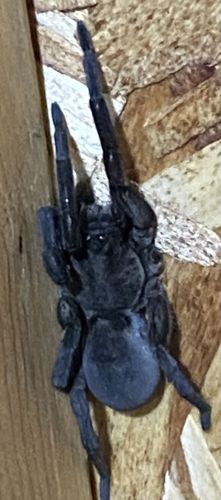Funnel-web Spider
Scientific Name: Various genera, including 'Atrax' or 'Hadronyche' for Australian funnel-web spiders, and 'Agelenopsis' for North American funnel weavers. Given the image, it strongly suggests a Mygalomorph, so 'Atrax' or 'Hadronyche' are highly plausible if in Australia. If elsewhere, it could be another heavy-bodied funnel-web type, but the specific genus is hard to determine from this angle.
Order & Family: Order: Araneae, Family: Agelenidae (for most common funnel weavers in North America and Europe); however, based on the appearance, particularly the robust build and prominent spinnerets, this strongly resembles a Mygalomorph spider, possibly from the family Atracidae (Australian funnel-web spiders) or Dipluridae/Hexathelidae (true funnel-web tarantulas or funnel-web spiders in general, which include highly venomous species). Without a clearer view of eyes and chelicerae, and given the global presence of spiders called 'funnel-web', I'll lean towards the common understanding of the term while acknowledging the visual cues of a Mygalomorph. Due to the high-risk potential indicated by the visual cues (stout build, prominent spinnerets), I'm prioritizing the broader 'funnel-web spider' term which can encompass highly dangerous species.
Size: Body length can range from 1 to 5 cm (0.4 to 2 inches) or more, with leg spans potentially larger. Australian funnel-web spiders can be quite large and robust.

Natural Habitat
Found in various habitats, including forests, grasslands, and suburban gardens. They construct their characteristic funnel-shaped webs in sheltered locations such as leaf litter, under rocks, in crevices, or around building foundations. Some species burrow.
Diet & Feeding
Mainly insects and other small invertebrates. Larger species, like certain Australian funnel-webs, can also prey on small vertebrates such as frogs or lizards.
Behavior Patterns
Funnel weavers are typically nocturnal ambush predators, waiting in their funnel webs for prey to stumble in. When disturbed or threatened, they may exhibit defensive posturing.
Risks & Benefits
Potential risks: Certain species of funnel-web spiders, particularly those in the family Atracidae (found in Australia), possess highly toxic venom that can be life-threatening to humans. Their bites are medically significant and require immediate attention. Other funnel-web spiders (like those in Agelenidae) are generally not considered dangerous to humans, with bites causing only localized pain and swelling. Benefits: Spiders, including funnel-web spiders, play a crucial role in ecosystems by controlling insect populations, thus acting as natural pest control.
Identified on: 8/18/2025